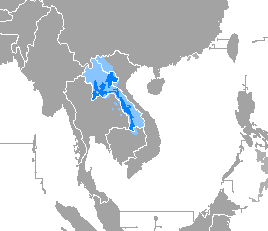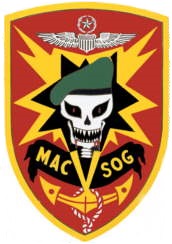| |||||
| Decades: | |||||
|---|---|---|---|---|---|
| See also: | Other events of 1965 List of years in Laos | ||||
The following lists events that happened during 1965 in Laos .
| |||||
| Decades: | |||||
|---|---|---|---|---|---|
| See also: | Other events of 1965 List of years in Laos | ||||
The following lists events that happened during 1965 in Laos .

Laos, officially the Lao People's Democratic Republic, is the only landlocked country in Southeast Asia. It is bordered by Myanmar and China to the northwest, Vietnam to the east, Cambodia to the southeast, and Thailand to the west and southwest. Its capital and most populous city is Vientiane. The country is characterized by mountainous terrain, Buddhist temples including the UNESCO World Heritage site of Luang Prabang, and French colonial architecture.

The People's Army of Vietnam (PAVN), officially the Vietnam People's Army, also recognized as the Vietnamese Army, the People's Army or colloquially the Troops, is the national military force of the Socialist Republic of Vietnam and the armed wing of the ruling Communist Party of Vietnam (CPV). The PAVN is the backbone component of the Vietnam People's Armed Forces and includes: Ground Force, Navy, Air Force, Border Guard and Coast Guard. Vietnam does not have a separate and formally-structured Ground Force or Army service. Instead, all ground troops, army corps, military districts and special forces are designated under the umbrella term combined arms and are belonged to the Ministry of National Defence, directly under the command of the CPV Central Military Commission, the Minister of National Defence, and the General Staff of the Vietnam People's Army. The military flag of the PAVN is the National flag of the Socialist Republic of Vietnam defaced with the motto Quyết thắng added in yellow at the top left.

Lao, sometimes referred to as Laotian, is the official language of Laos and a significant language in the Isan region of northeastern Thailand, where it is usually referred to as the Isan language. Spoken by over 3 million people in Laos and 3.7 million in all countries, it serves as a vital link in the cultural and social fabric of these areas. It is written in the Lao script, an abugida that evolved from ancient Tai scripts.

The Ho Chi Minh Trail, also called Annamite Range Trail was a logistical network of roads and trails that ran from North Vietnam to South Vietnam through the kingdoms of Laos and Cambodia. The system provided support, in the form of manpower and materiel, to the Viet Cong and the People's Army of Vietnam (PAVN), during the Vietnam War. Construction for the network began following the North Vietnamese invasion of Laos in July 1959. At the time it was believed to be the main supply route, however it later transpired that the Sihanouk Trail which ran through Cambodia was handling significantly more material.

The Pathet Lao, officially the Lao People's Liberation Army, was a communist political movement and organization in Laos, formed in the mid-20th century. The group ultimately gained control over the entire country of Laos in 1975, after the Laotian Civil War. The Pathet Lao were always closely associated and dependent on Vietnamese communists and North Vietnam since their foundation, with the group being established after advice from Hanoi to create a Laotian counterpart of the Viet Minh or Viet Cong. During the civil war, it was effectively organised, equipped and even led by the People's Army of Vietnam (PAVN). They fought against the anti-communist forces in the Vietnam War. Eventually, the term became the generic name for Laotian communists. Under orders from Mao Zedong, the People's Liberation Army provided 115,000 guns, 920,000 grenades and 170 million bullets, and trained more than 700 of its military officers.

The Laotian Civil War was waged between the Communist Pathet Lao and the Royal Lao Government from 23 May 1959 to 2 December 1975. The Kingdom of Laos was a covert theater during the Vietnam War with both sides receiving heavy external support in a proxy war between the global Cold War superpowers. The fighting also involved the North Vietnamese, South Vietnamese, American and Thai armies, both directly and through irregular proxies. The war is known as the Secret War among the American CIA Special Activities Center, and Hmong and Mien veterans of the conflict.

Air America was an American passenger and cargo airline established in 1946 and covertly owned and operated by the Central Intelligence Agency (CIA) from 1950 to 1976. It supplied and supported covert operations in Southeast Asia during the Vietnam War, including allegedly providing support for drug smuggling in Laos.
Yankee Station was a fixed coordinate off the coast of Vietnam where U.S. Navy aircraft carriers and support ships operated in open waters over a nine-year period during the Vietnam War. The location was used primarily by aircraft carriers of Task Force 77 to launch strikes over North Vietnam. While the coordinate's official designation was "Point Yankee", it was universally referred to as Yankee Station. Carriers conducting air operations at Yankee Station were said to be "on the line" and statistical summaries were based on days on the line. Yankee Station was initially located at 16° 00′ N, 110° 00′ E, however with a massive increase in operations over North Vietnam in 1966 the station was moved about 145 miles (230 km) northwest to 17° 30′ N, 108° 30′ E, placing it about 90 miles (145 km) from the North Vietnamese shore.

The Southeast Asian Games, commonly known as SEA Games is a biennial multi-sport event involving participants from the current 11 countries of Southeast Asia. The games are under the regulation of the Southeast Asian Games Federation with supervision by the International Olympic Committee and the Olympic Council of Asia.

Military Assistance Command, Vietnam – Studies and Observations Group (MACV-SOG) was a highly classified, multi-service United States special operations unit which conducted covert unconventional warfare operations before and during the Vietnam War.
The United States Air Force (USAF) deployed combat aircraft to Thailand from 1960 to 1975 during the Vietnam War. Today, US military units train with other Asian militaries in Thailand. Royal Thai Air Force Bases are an important element in the Pentagon's "forward positioning" strategy.
Ubon Royal Thai Air Force Base is a Royal Thai Air Force (RTAF) facility located near the city of Ubon Ratchathani, in Ubon Ratchathani Province. It is approximately 488 km northeast of Bangkok. The Laos border is about 60 kilometres (37 mi) directly east. The facility is also used as a civil airport.

Operation Steel Tiger was a covert U.S. 2nd Air Division, later Seventh Air Force and U.S. Navy Task Force 77 aerial interdiction effort targeted against the infiltration of People's Army of Vietnam (PAVN) men and material moving south from the Democratic Republic of Vietnam through southeastern Laos to support their military effort in the Republic of Vietnam during the Vietnam War.

Operation Tiger Hound was a covert U.S. 2nd Air Division, later Seventh Air Force and U.S. Navy Task Force 77 aerial interdiction campaign conducted in southeastern Laos from 5 December 1965 till 11 November 1968, during the Vietnam War. The purpose of the operation was to interdict the flow of People's Army of Vietnam (PAVN) supplies on the Ho Chi Minh Trail from the Democratic Republic of Vietnam, through southeastern Laos, and into the northern provinces of the Republic of Vietnam. The missions were originally controlled by the 2d Air Division until that headquarters was superseded by the Seventh Air Force on 1 April 1966.

Operation Barrel Roll was a covert interdiction and close air support campaign conducted in the Kingdom of Laos by the United States military between 5 March 1964 and 29 March 1973, concurrent with the Vietnam War. During the operation, U.S. Air Force 2nd Air Division and U.S. Navy Task Force 77 dropped 260 million bombs on Laos.

Operation Pony Express was the covert transportation of, and the provision of aerial support for, indigenous soldiers and material operating across the Laotian and North Vietnamese borders during the Vietnam War. It was provided by Sikorsky CH-3C helicopters of the US 20th Helicopter Squadron, the only USAF combat helicopter squadron in Vietnam, which had been transferred there in 1965 and was known as the "Pony Express".
Boun Oum Airways or BOA, was a Laotian airline owned by Prince Boun Oum. After 1965 BOA expanded using aircraft on loan from Continental Air Services, Inc (CASI). BOA's aircraft did not carry any logo or titles and their Thai pilots were integrated with CASI by early 1967.
Operation Hardnose was a Central Intelligence Agency-run espionage operation spying upon the Ho Chi Minh trail that began during the Laotian Civil War. Started in Summer 1963, it soon attracted the attention of the U.S. Secretary of Defense, Robert McNamara. By December 1963, he was calling for its expansion. Operation Hardnose expanded and continued to report on the Ho Chi Minh trail even as American military intelligence activities mounted against the communist supply artery. In an attempt to adapt technology for use by illiterate Lao Theung, some of the U.S. Air Force's survival radios were modified by the CIA for use by their spies.
The 1965 Laotian coups were two separate and simultaneous coups that struck the Kingdom of Laos in January 1965. General Phoumi Nosavan, a participant in four prior coups, had been deprived of troop command as a result; nevertheless, he managed to come up with troops for another try at overthrowing the Royal Lao Government. Simultaneously, Colonel Bounleut Saycocie independently mounted his own coup; after a short term takeover of Vientiane's radio station and infrastructure, he and his coup troops would rejoin the government forces sent to attack them. General Kouprasith Abhay, the military region commander, suppressed both coups. After re-acquiring Bounleut's troops, Kouprasith turned on the national police force and its commander, Siho Lamphouthacoul, as he felt they were untrustworthy and likely to join Phoumi's coup. The police force was defeated and disbanded. The troops Phoumi counted on never reached Vientiane; they were defeated and dispersed. By 4 February 1965, both coups were defeated. A purge of suspected dissident officers from the Lao officer corps followed.

India–Laos relations, also referred to as Indian-Lao relations or Indo-Lao relations, are bilateral relations between India and Laos. Relations between two nations were established in February 1956. First Prime Minister of India Jawaharlal Nehru visited Laos in 1954 while first President of India Rajendra Prasad visited Laos in 1956. India considers Laos as strategically important in accordance with China's growing land-reclamation activities in the South China Sea. Laos has been supportive to India's efforts to become a permanent member of the UN Security Council.